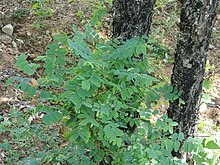Chloroxylon swietenia
| Chloroxylon swietenia | |
|---|---|

| |
| Ragihalli Forest, Bengaluru district, India. | |
| Scientific classification | |
| Kingdom: | |
| (unranked): | |
| (unranked): | |
| (unranked): | |
| Order: | |
| Family: | |
| Subfamily: | |
| Genus: | |
| Species: | C. swietenia
|
| Binomial name | |
| Chloroxylon swietenia | |
Chloroxylon swietenia (Ceylon satinwood, East Indian satinwood or buruta (බුරුත in Sinhala)) is a tropical hardwood, the sole species in the genus Chloroxylon (from the Greek χλωρὸν ξύλον, "green wood"). It is native to southern India, Sri Lanka, and Madagascar.[1]
Ceylon satinwood is a medium-sized deciduous tree, growing to 15–20 m tall, with thick, fissured, slightly corky bark and pinnate leaves. The flowers are small, creamy-white, produced in panicles; the fruit is an oblong three-segmented capsule 2.5-4.5 cm long, containing 1-4 seeds in each segment.


Uses
The wood, a satinwood, is often a golden colour with a reflective sheen. It is used for small luxury items and as a veneer in wooden furniture.
Conservation
Populations have declined due to overexploitation.[1]
References
- ^ a b Asian Regional Workshop (Conservation & Sustainable Management of Trees, Viet Nam, August 1996). 1998. Chloroxylon swietenia. In: IUCN 2013. IUCN Red List of Threatened Species. Version 2013.1. Downloaded on 24 July 2013.

